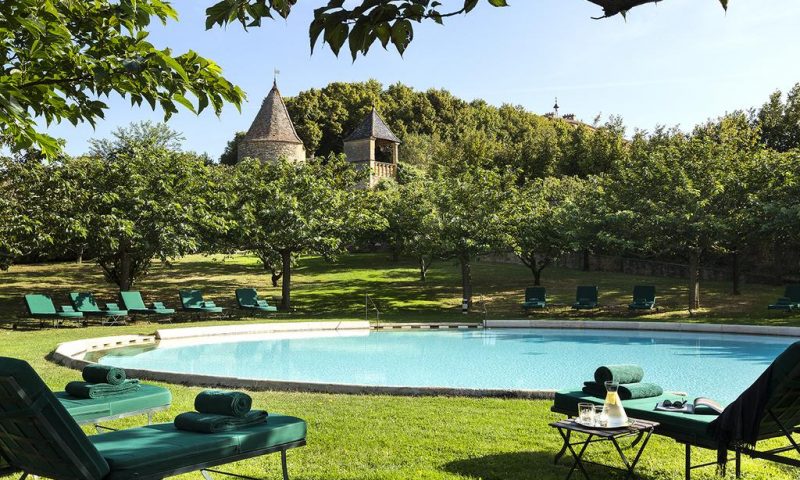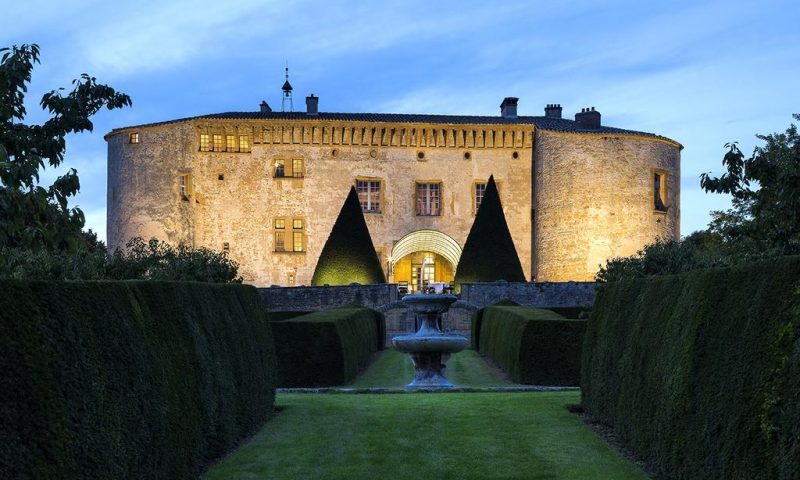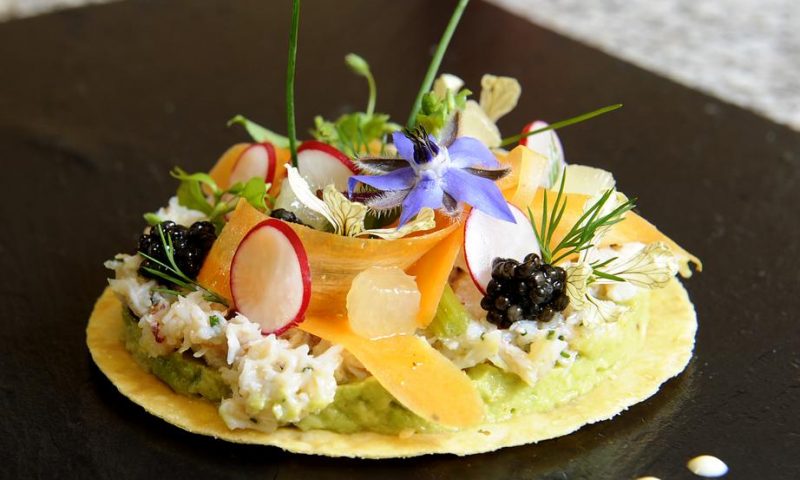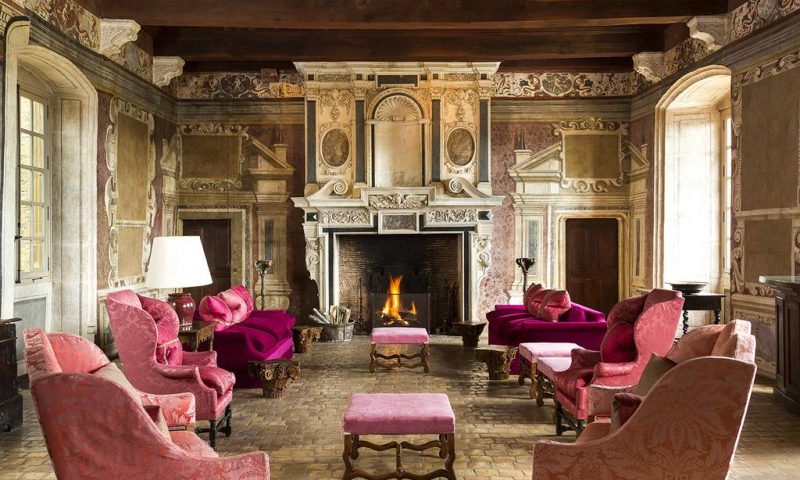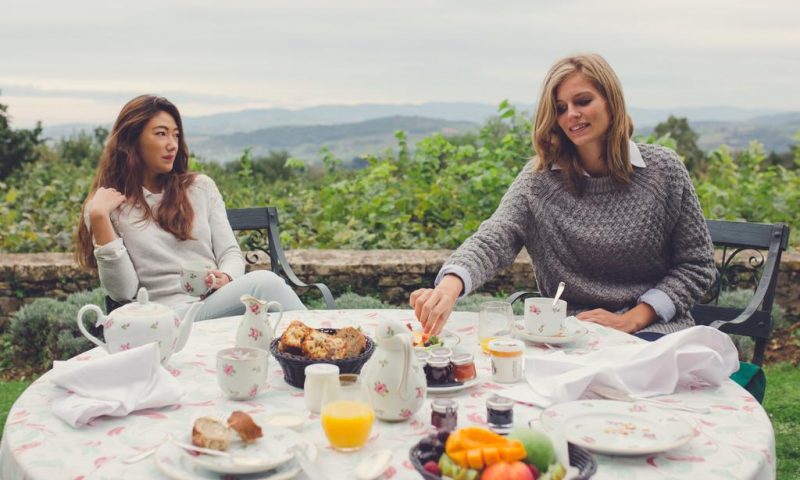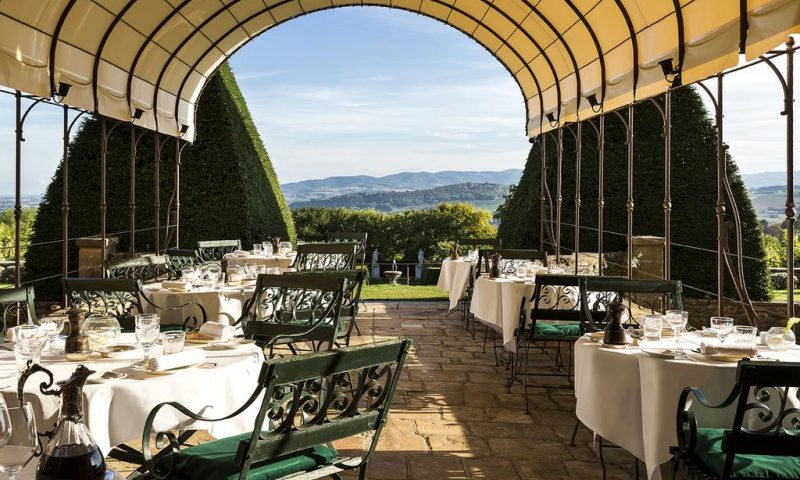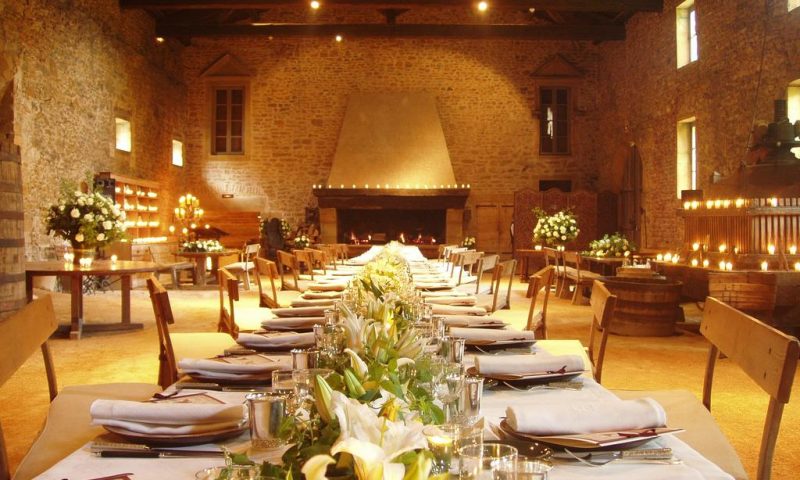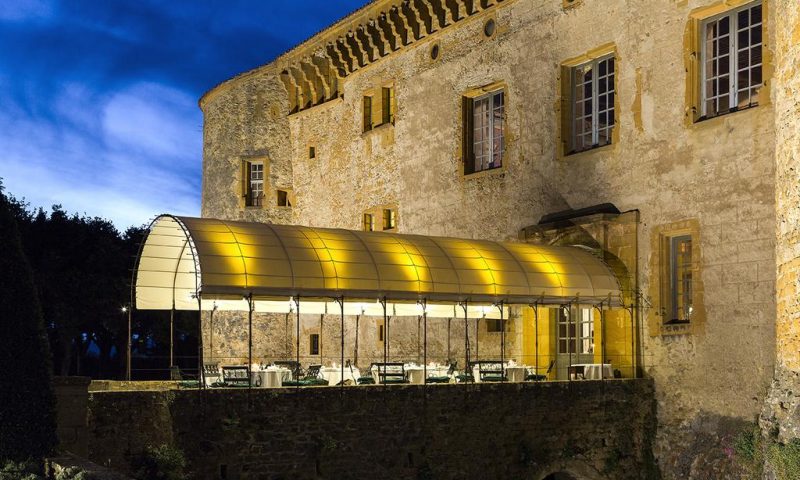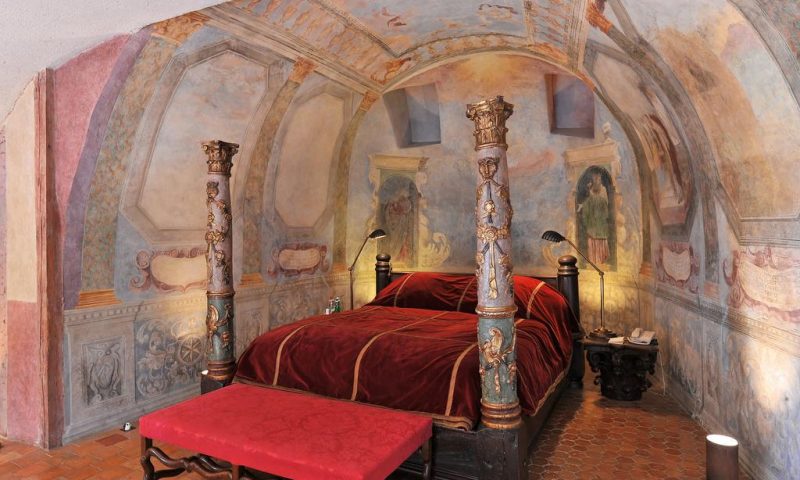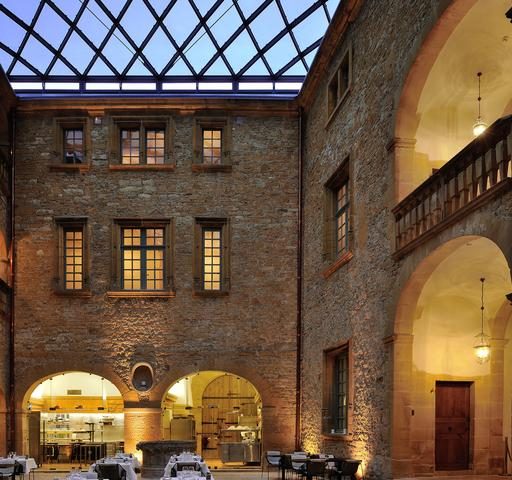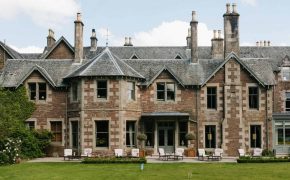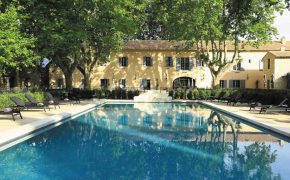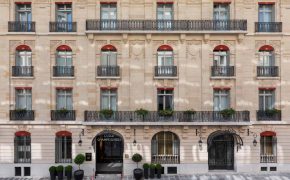The Château de Bagnols was built on the lands of the Lords of Oingt in the heart of the Beaujolais vineyards and the Monts du Lyonnais.
In 1217, Guichard d’Oingt, a powerful lord in the Beaujolais region, undertook the construction of a vast Château which, in size, is the equal of the largest buildings of the Aristocracy and the Clergy.
It is during this era that work was started on building the Château, its fortifications and its moat. it was designed to look out over the valley, and from its towers, watch could be kept over the whole of the surrounding region. This key date lent its name to the Château de Bagnols’ current gourmet restaurant, The 1217.
THE ALBON LORDS
Eléonore, the granddaughter of Guichard d’Oingt, married Guillaume d’Albon in 1288 and this illustrious family took over the fiefdoms of Bagnols which it then controlled for 6 generations.
Towards the middle of the XIVth century, the region fell victim to numerous disasters – floods, climate disorders, epidemics, followed by their lots of misery and famine. In 1337, war broke out, marauding bands of looters criss-crossed the region, spreading disorder and terror. Churches were abandoned and villages deserted.
THE BALZAC LORDS
In 1453, the marriage of Jeanne d’Albon and Rauffec de Balsac places the Château under this family’s coat of arms. This is when the North tower was built incorporating embrasures to strengthen the Château’s defences.
Geoffroy de Balzac, son of Rauffec, was raised at court, he was first a page before becoming advisor to King Charles VIII, whom he received in his Château de Bagnols in October 1490 when the King was just 20.
To commemorate his visit, a crown was cut in the stone on the fireplace of the Salle des Gardes. This visit was a supreme honour that marked a page in the history of the Château. Geoffrey de Balzac later married Claude Leviste, who is thought to be the lady from the famous “Lady and the Unicorn” tapestries.
THE CHABANNES LORDS
Claude then married a relative, Jean de Chabannes, who took possession of her estate. The Bagnols lands were subsequently sold in 1566 to Jehan Camus and his sons.
THE CAMUS LORDS
This family occupied Bagnols for 3 generations until 1619, date on which the domain was sold to Gaspard Dugué.
THE DUGUÉ LORDS
In the XVIIth century the Château became the favourite residence of the Dugué family that created numerous decorations in Bagnols. The Dugués were connected by marriage to the marquise de Sévigné, who mentioned her visits to the Château in her voluminous correspondence.
Gaspard Dugué carried out major repair work. He employed a master of water to bring water to the Château from the pond in the lower courtyard to the cast iron taps in the kitchen.
Gaspard was the first owner of Bagnols to make it his main residence. He invested large amounts of money to glorify it by reinforcing its defensive character, symbol of its power and its nobility.
THE HESSELER LORDS
In 1711, Barthélémy Joseph Hesseler purchased “the Seigneury and Barony of Bagnols”. He maintained it carefully and embellished it, to do this he hired François Aricor. This period saw the end of certain defensive elements (machicolation, bartizan, drawbridge counterpoise…).
THE CROPPET DE VARISSAN LORDS
Barthélémy’s daughter, Marie-Anne, married Jean-Baptiste Croppet de Varissan who owned Bagnols from 1751 to 1782. At the time of his death the Domaine de Bagnols was estimated to be worth 600,000 pounds, including 19,000 for the furniture and ornaments.
THE SAINT TRY LORDS
Claudine Barthélémy inherited the Château on the death of her father. She married a friend of the family, owner of the Château de Saint-Try and numerous other domains. In 1796, the Domaine de Bagnols was broken up to be sold.
THE CHAVANIS LORDS
Claude Chavanis bought the Château for 160,000 pounds. Bagnols then underwent further developments over the second half of the XVIIIth century.
The French Revolution did not cause too much damage to Bagnols. Only the large towers, symbols of the power of the seigneurs, were said to have been destroyed during this period, along with a number of crests.
Because it was used as a revolutionary council hall, and because the judge lived there, the Château was saved from destruction. In fact, the Salle des Gardes served as a meeting place for revolutionaries.
At the death of Claude Chavanis, her son Auguste inherited the Château. He considered his land of Bagnols to be a wine-growing holding, he bought vineyards and built the vast vat room.
THE JOUFFRAY LORDS
Françoise Anne Julie Chavanis inherited the Château from her father. She was married at the time to Jean Antoine Morand de Jouffray, descendant of the famous architect Jean Antoine Morand, creator of the Brotteaux district in Lyon and who was hanged during the Revolution.
Their daughter Amélie Morand de Jouffray inherited Bagnols in 1881.
THE CHEVALARD LORDS
Jules Lucien Souchon du Chevalard, Chevalier de la Légion d’Honneur and Prefect of the Ardèche married Amélie Morand and became the owner of Bagnols. In 1899, their daughter Antoinette gave the Château as dowry to Count Joseph Boutechoux de Chavanes.
THE CHAVANNES LORDS
They had three children, one of whom was Marie Antoinette, the owner of the Château until 1980.
In 1940, during the Second World War, the treasures of the Saint-Jean Cathedral were transferred to the Château in order to protect them from the bombings. The Salle des Tonneaux thus served as place of protection to save the heritage of the town of Lyon.
The Château was abandoned and slowly decayed, its owner only occupying the apartments on the ground floor, in the West wing during the summer months. The condition of the main building was critical, the roof collapsed in a number of places, the walls developed cracks.
One by one the roofs fell in – those of the outhouses first, followed by those of the vat room which, already weakened by infiltrations of rainwater, collapsed due to the “supersonic boom” caused by an airplane in 1970.
MR ROCHE
In 1980, Mr Roche bought the Château from the descendants of Madame Boutechoux de Chavanes. He sold it seven years later, in 1987, to Paul and Helen Hamlyn.
PAUL & LADY HAMLYN
The passion of Paul and Helen Hamlyn for this region of France was the motivation behind their decision to acquire the Château de Bagnols. The Hamlyns subsequently devoted a large part of their time to bringing the Château back to life, whilst retaining its historic character and its venerable appearance.
Four years of meticulous and faithful restoration were needed to restore this building to its former glory. The Hamlyn’s architect, Tom Wilson, took charge of the work using the most advanced and often innovative techniques, to consolidate the building and install new services whilst retaining its traditional features.
The building was rescued from years of abandon to rise again in its new role, in 1992, namely that of an elegant 4-star luxury hotel-restaurant which has won the admiration of the rich and famous.
GROUPE VON ESSEN HOTEL
From 2007 to 2012, the Château was owned by Groupe Von Essen Hotels.
JEAN-CLAUDE LAVOREL
In June 2012, after it was put up for sale, the Château de Bagnols was acquired by an entrepreneur from Lyon, Jean-Claude Lavorel, CEO of the Lavorel Group. The Château was then incorporated into Lavorel Hotels, the hotel subsidiary of Groupe Lavorel.
Major changes were implemented at the initiative of the new owner, who oversaw the construction of a majestic glazed roof over the inner courtyard.
This was followed by the opening of a luxury spa, a gym fitted with state-of-the-art equipment, and a “beauty farm” area. Finally, 6 new contemporary suites were opened following development work carried out in the old vat room.
The twenty-seven suites have now been named after the famous people who contributed to the Château’s glorious past: Guichard d’Oingt Suite, Honoré de Balzac Suite, Madame de Sévigné Suite, to mention but a few.
The Château de Bagnols is now the new 5-star establishment of the département. Atout France awarded it its fifth star on 1 July 2013.
SUITES
Time has no effect on the Château de Bagnols. It might even be that the privilege of spending a night in this place steeped in history is an experience which becomes more rich and intense with each day that passes.
Majestic suites at the heart of the medieval Château, garden suites in direct contact with the natural landscape of the region of the golden stones, cellar suites with their resolutely contemporary architecture, choose your vision of one of the best reasons to love France.
SUITES CHÂTEAU
The very essence of Bagnols, a stunning collection of unique apartments situated in the main building of the Château, each offering the opportunity to experience a part of the history.
Walls richly decorated with XII to XVIII murals, four-poster beds, stylish furniture, decorative fireplaces and marble bathrooms, the immersion is total and the experience unique.
SUITES CHAI
Transformed by the skilful hands of architect Albert Constantin, the huge golden stone building, formerly the Château cellar, is now home to an unusual set of suites with curved lines evoking the ancient barrels, a successful marriage of contemporary design and the spirit of Bagnols.
Understated and luxurious furniture, pastel palettes, huge bathrooms and a soothing design featuring predominantly wood and golden stone.
SUITES JARDIN
In the spacious outbuildings of the Château, between the vast inner courtyard and the rolling hills that surround them, a group of rooms in the purest historic style with hints of nature.
Among these, the famous Lady Hamlyn suite, the apartment of the eponymous and iconic former owner of the property, which has been converted into a spectacular duplex.
DINING
Within the age-old walls of the Château de Bagnols drifts a very present-day aroma, straight from the kitchens of the Michelin starred chefs. As dependable as the solidness of the setting, as creative as the inspiration of the ambience, the chef, making restaurant 1217 a new and vibrant experience.
1217 RESTAURANT
These were the words of Thomas of Aquin, contemporary of the Château’s creation, the year of which, 1217, gives the restaurant its name, and confirm his key role in the Bagnols experience today.
Shining bright, the cuisine of the Michelin starred chefs uses simplicity and colour, love of the produce and the terroir, revisited with a seasonal vibrancy which transcends decor and gastronomy as we know it.
A pure pleasure of discovery in the majestic Salle des Gardes or on the panoramic terrace which dominates the region of the Pierres Dorées.
WELL-BEING
What could be more natural at the Château de Bagnols than to offer a timeless pause? Combining the serenity of a place of history with the most cutting-edge technicality of the brands and equipment, it offers its hosts and urban guest seeking well-being moments of pure pleasure. Beauty, fitness, relaxation, welcome to the Château.
SPA
The peaceful ambience stemming from the surrounding countryside, the calm interior of the Château, so conducive to introspection, the harmonious balance of an age-old site whose history continues daily to be written, make the Château de Bagnols a perfect destination for an hour, a day, or a peaceful break.
With the cutting edge expertise of the Sothys brand, the range of treatments is provided by an attentive professional team.
FITNESS
A space dedicated to fitness is where you’ll find the latest Technogym cutting-edge sporting technology. The Château de Bagnols is not only a place of culture but also of physicality. Unless you prefer a morning run among the vines!
BEAUTY FARM
At the Château de Bagnols, nail artists have replaced the mural artists of centuries past, but their work dedicated to beauty continues.
OUTSIDE
Walks in the grounds or in the surrounding countryside, where you can enjoy the clean air and timeless atmosphere of an elegant French landscape.
A tree-planted courtyard where a fountain murmurs, the classical vision of fine French gardens, an orchard planted with cherry trees, long tree-lined walks, elegant and mysterious covered passages, an aromatic garden, a terrace under the lime trees, a stunning circular Roman pool, the Château’s park has a thousand treasures.
The swimming pool will be closed as from September. It will reopen with sunny days.
ACTIVITIES
It is beyond doubt that this region is one of nature, unspoilt by large groups of tourists and valued by connoisseurs of authentic terroirs. Rich in discoveries, emotions and encounters, the region of the golden stones has a charm that the Château de Bagnols invites you to experience as insiders.
LAC DES SAPINS IN CUBLIZE
Lac des Sapins (fir tree lake) in Beaujolais Vert, is a lake that is popular with walkers, bathers and fishermen alike. As for sporting enthusiasts, they are spoilt for choice: sailing, paintball, the Forêt de l’Aventure acrobatic forest trail, horse riding, hiking, cycling and more.
Also on site: walks and on-land GPS-assisted games with the GPTO Mission and in pedal boats with the Pedal Boat Mission, electrically assisted bicycles, tree houses, Segways and the largest natural biological swimming pond in Europe
THE BEAUJOLAIS WINE ROUTE
The Beaujolais vineyard is famous worldwide and boasts an infinite number of treasures and flavours. And the Beaujolais tourist wine route, which includes 12 appellations, will teach you all there is to know about its heritage, wines and landscapes: the prestigious crus, the bell towers in Beaujolais Villages, the sun-drenched Beaujolais slopes and the picturesque villages in the Pierres Dorées area…
This linear itinerary will take you across all the terroirs of Beaujolais crus as well as the Beaujolais-Villages and Beaujolais controlled appellations of origin estates.
From Saint-Amour to the north, it crosses the crus and villages all the way to Lozanne: 140 km to discover the Beaujolais area through its vines, its people and its heritage.
THE REGION OF BEAUJOLAIS CRUS
The Beaujolais region is a subtle blend of soils, grape varieties and people. It is the full and magical expression of a terroir.
The “most sensual of vineyards” extends over 17,324 hectares along a strip of land 10 to 15 kilometres wide and 50 kilometres long, that winds from Mâcon in the north to Lyon in the south along the hilly slopes of the Monts du Beaujolais which rise to an altitude of 700 to 1,000 m.
The Gamay Noir grape variety reigns supreme on this land blessed by the gods, and in the most spectacular way, as it offers an extraordinary array of wines, from the subtlest and most aromatic with Beaujolais and Beaujolais Villages wines, to the most potent and complex, seeing as the ten Beaujolais crus all have their own specific characteristics which are related to their different terroirs: Brouilly, Chiroubles, Chénas, Côte de Brouilly, Fleurie, Juliénas, Morgon, Moulin-à-Vent, Régnié and Saint-Amour.
This region is best enjoyed by taking a slow drive along the Beaujolais wine route.
HAMEAU DUBOEUF
Unique in Europe, the first park devoted to wine and the vine! Whether with family or friends, expert or novice, Hameau Dubœuf invites you to a magical world dedicated to wine and the vine!
Extending over 30,000 m2 at the heart of Beaujolais, it will offer a fun and original presentation of all the secrets of our vineyards, their origins, their locations and their techniques.
DOMAINE DE ST CYR
Discover all the specialities in a magnificent setting with breath-taking views over the Beaujolais. Enjoy a free tasting of numerous Beaujolais wines produced here. They are set apart thanks to the BIO label which characterises the wines produced by the vines grown by the family under organic farming conditions.
GOLF DU BEAUJOLAIS
An 18-hole course among the vines! The course is pleasant to play and in terms of technique, and is accessible to all levels. There are lateral water obstacles at 8 holes, the greens are vast and the surfaces well-tended.
Thanks to the drainage and the hilly terrain, you can play all winter on the summer tees and greens. 20 Km north of Lyon, the countryside surrounding the golf course offers players a view of valleys with rows of vines and golden stone villages.
HIKING TRAILS
The Beaujolais des Pierres Dorées area boasts close to 1,200 km of marked hiking trails. These tours can be adapted to your level of fitness and projects. They have been chosen for their interest in terms of heritage and scenery.
Trail markers are regularly maintained in partnership with the Departmental Council of the Rhône region and local associations to ensure that all walks and hikes are safe. Maps are available at the Beaujolais des Pierres Dorées Tourist Information Office.
ESPACE DES PIERRES FOLLES
With its museum, botanical garden, and geological trail, the Espace Pierres Folles invites you to embark on a trip through time, in the very heart of Beaujolais des Pierres Dorées country.
THE PAUL-DINI MUSEUM
Located in the very heart of Villefranche-sur-Saône, the municipal Paul-Dini museum invites you to discover a comprehensive overview of paintings from the Rhône-Alpes region, from 1865 to the present.
THE CLOISTER IN SALLES-ARBUISSONNAS
Discover the Priory, a lovely museum that retraces the history of Salles-Arbuissonnas. Explanatory texts will guide you through the site to help you appreciate the many arts that have marked the site. This is the last Romanesque cloister in the Rhône region!
The Priory invites you to discover the site’s rich history, from the Neolithic Period to the arrival of the Benedictines, including the construction of a Romanesque cloister during the 10th century (the last in the Rhône area) and its development up until the 18th century.
It relates the lives of the Chanoinesses Comtesses (Canoness Countesses), powerful noble women who were part socialites and part nun, and deeply marked the history of the village.
Chapters made up of noble women were not common in the region, which made the Priory uniquely original. Now listed as a historical monument, it boasts many works of art that are characteristic of the different times and customs. The Priory is a little gem in the Beaujolais area, and not to be missed.
FILMING
There are many who think that the Château de Bagnols (XIII century), a 5-star hotel establishment, is the finest château-hotel in the world. A haven of peace and serenity, the Château de Bagnols, which is one of the major historic monuments of France, is an architectural gem.
Its moats, its perimeter towers and its golden stones give it its majestic soul and invite a unique journey through the history of France.
Surrounded by splendid French gardens and vines, the Château offers exceptional moments: a Roman pool, a gastronomic restaurant in the Salle de Gardes and uniquely positioned reception rooms. An indispensable and magical place for filming and shoots, prices on request.
SEMINAR & BANQUETING
To gather at the Château de Bagnols offers a stimulating experience. It’s not every day you can hold a conference in the Grand Salon frequented so often by Madame de Sévigné or set a ceremonial table in the Salle des Tonneaux, where the buzz of the winemakers returning from the vine harvests of Beaujolais still echoes.
CELEBRATIONS
For your memorable moments, choose a place that’s unforgettable. In its soon to be 8 centuries of existence, no one could say how many marriages, anniversaries, victories or exceptional moments have been celebrated within the walls of the Château de Bagnols, but its charm remains intact and the magic is at work, full of memories, imagined recollections and natural emotions.
